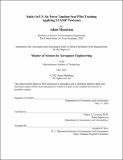| dc.contributor.advisor | Leveson, Nancy G. | |
| dc.contributor.author | Munekata, Adam | |
| dc.date.accessioned | 2022-08-29T16:15:25Z | |
| dc.date.available | 2022-08-29T16:15:25Z | |
| dc.date.issued | 2022-05 | |
| dc.date.submitted | 2022-06-09T16:14:43.758Z | |
| dc.identifier.uri | https://hdl.handle.net/1721.1/144840 | |
| dc.description.abstract | The complexity and sophistication of modern systems pose many challenges for conventional accident and hazard analysis techniques. Although these methods have proven to be reliable on systems in the past, these methods often lack context, are subject to impartiality, and fail to approach systems holistically. System-Theoretic Accident Model and Process (STAMP) addresses these challenges and helps to identify how unsafe control actions can lead to hazards.
This thesis applies (STAMP) principles to an accident assessment and hazard analysis of tandem seat pilot training in the United States Air Force (USAF). The USAF Safety investigation board (SIB) process has gained valuable insight from accidents in the past; however, it suffers from the shortcomings mentioned above.
Northrup Grumman’s T-38 Talon is the advanced jet trainer that has been used by the USAF since the 1960s, soon to be replaced by Boeing’s T-7 Red Hawk as early as 2023. Causal Analysis based on Systems Theory (CAST) is an accident analysis technique based on STAMP. CAST is applied to the USAF SIB Report of the recent Vance T-38 crash on 21 November 2019. The findings of the SIB report are compared with the findings of CAST. Recommendations are provided to improve the SIB process by applying STAMP principles.
System Theoretic Process Analysis (STPA) is a hazard analysis technique based on STAMP principles. STPA is applied to a hypothetical Next Generation Trainer since the specifications of the T-7 are not known. Recommendations are generated to improve safety, focusing primarily on the conflict of control authority between the instructor and student pilots. Design recommendations and suggestions are provided for the next generation trainer to address concerns that may have been overlooked in preliminary hazard analysis. | |
| dc.publisher | Massachusetts Institute of Technology | |
| dc.rights | In Copyright - Educational Use Permitted | |
| dc.rights | Copyright retained by author(s) | |
| dc.rights.uri | https://rightsstatements.org/page/InC-EDU/1.0/ | |
| dc.title | Safety in US Air Force Tandem Seat Pilot Training Applying STAMP Processes | |
| dc.type | Thesis | |
| dc.description.degree | S.M. | |
| dc.contributor.department | Massachusetts Institute of Technology. Department of Aeronautics and Astronautics | |
| dc.identifier.orcid | 0000-0002-4619-5515 | |
| mit.thesis.degree | Master | |
| thesis.degree.name | Master of Science in Aeronautics and Astronautics | |
